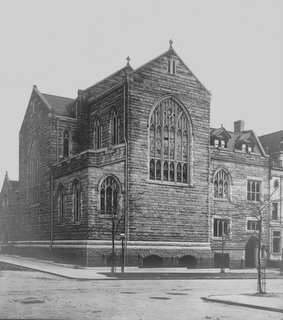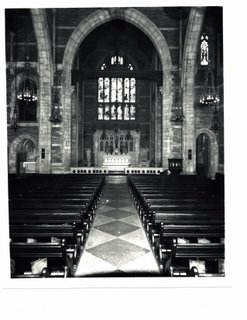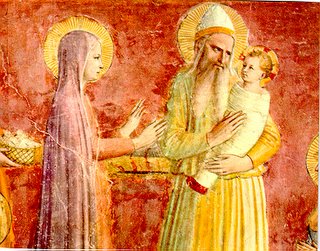
This is thy temple; here thy presence chamber.
Here may thy servants, at the mystic banquet,
Humbly adoring, take thy Body broken,
Drink of thy chalice.
Hallowed this dwelling where the Lord abideth,
This is none other than the gate of heaven;
Strangers and pilgrims, seeking homes eternal,
Pass through its portals.[Rouen]
The Feast of the Dedication dawned with surreal lightning flashes and a chorus of rolling thunder that seemed to rumble on for minutes at a time. We were in the eye of the blizzard of ’06 I later found out, a massive storm that started down in Texas and gathered a lot of warm air on its way here, so the collision of warm and cold air caused quite a display as the blizzard blew into Manhattan. After a restless night of disquieting dreams after watching
Hide and Seek (with a truly scary DeNiro), I stumbled wearily to the window, resigning the day to an earlier start than I had planned, and looked out upon an iridescent orange sky snowing heavy wet snow at a very fast clip. Technically it wasn’t quite a blizzard here in the city, but it sure felt like it as I made my way over to the church. Bless their hearts, the Building & Grounds crew were there shoveling away and soon we had the cleanest walk in the hood. It was the biggest snowfall recorded since they started keeping records in 1869, an impressive 26.9 inches by the time it stopped around 4 pm. [I read somewhere that the Central Park “official precipitation” gauge is actually a stick in the snow outside the sea lion’s den, which is read by a security guard, so who knows how accurate it is, but it was definitely a lot of snow.]
Only about 44 people made it to church (at least half of them in the sanctuary and choir) but it was a divine liturgy all the same. I was MC and somehow we managed to have a full complement of servers as well as an attending priest, our new associate Stephen Harding, who skied down from the Cathedral. After a rousing prelude of Messiaen’s
Apparition de l’Eglise eternelle superbly done by Mr. Keilitz, we processed around the church to the station at the Rood singing
Rouen (2d tune), one of my all-time favorites. Then we sang
Aurelia, another favorite, back at the sedelia and it was Solemn Mass with humeral veil as usual thereafter, with no misbehaving candles for once. The choir did a splendid job with the wonderful Missa
Nisi Dominus of Pierre de Manchicourt and Bairstow’s glorious
Blessed city, heavenly Salem which, though rather long for an offertory anthem, was magnificent. The Proper Preface of the Dedication, sung most heartily by the Rector, went on for awhile also, but as I marked the book I felt like I was really hearing the words for the first time.
… And verily thy Church is the true House of Prayer, of which these visible buildings are but the figures. It is the Temple of the habitation of thy glory, the Throne of unchanging truth, the Holy Place wherein everlasting love abideth. It is the Ark which bringeth us, who are delivered from the deluge of the world, into the haven of salvation. …This was the 81st anniversary of the dedication of St. Ignatius as a house of worship. It was opened in 1902 but in those days a church could not be consecrated until the mortgage was paid off, so it was not until February 8, 1925 that the church was canonically consecrated to the glory of God, in honor of St. Ignatius, Bishop and Martyr, and in memory of Arthur Ritchie, Priest and Rector. Bishop William T. Manning did the honors.
In 1925 St. Ignatius was grateful to finally have a bishop that was supportive of Catholic practice after decades of pontifical disapproval over Fr. Ritchie’s introduction of full Catholic ritual upon his arrival in 1884. Dr. Ewer, our founding rector, had problems enough of his own over his Catholic leanings, but Fr. Ritchie was considerably more “advanced” than Dr. Ewer in his use of vestments, candles, incense, holy water, confessionals, reservation of the Sacrament, Benediction (it was believed to be the first instance of Benediction ever practiced in the American church, called “Adoration”) and the so-called non-communicating High Mass, where only the celebrant receives, the faithful having come to one of the four Low Masses earlier for their fasting communion.
Fr. Ritchie’s ill heath forced him to resign after a 30 year tenure, and Fr. William Pitt McCune took things even higher over the next 30 years, introducing the full Kalendar of Saints Days, Stations of the Cross, Tenebrae, Holy Week ceremonies, the Angelus, three beautiful statues and a gorgeous font by Cram and Ferguson, and use of the
American Missal with Introit, Sequence and Offertory included in the Mass.
So we have come a long way from Dr. Ewer’s plain linen chasuble (except on high feasts when he wore brocaded silk), “no biretta” days. As it says at the end of Louis Gray’s
History of St. Ignatius:
It is, in great part, a stormy tale, but storm and strife are the lot of all who strive steadfastly for the right and the true. From the days of Dr. Ewer at Christ Church to this moment St. Ignatius’ has had but one goal and one aim, and from this it has never swerved: devotion to our Blessed Lord and love of Him, especially in the Holy Sacrament of the Altar; increase of that devotion and that love in the hearts of all who profess and call themselves Christians; constant progress in the richness of the rites of the Holy Catholic Church; absolute adherence to her historic Creeds and historic traditions; veneration of the Blessed Saints and super-veneration of our Lady; unceasing remembrance of the faithful departed – the Catholic Faith undiminished, unimpaired, enriched. …”
 I had heard of the pulpit many times and often wondered what it had looked like. I knew it used to reside where the statue of St. Ignatius now stands, on the epistle side just outside the communion rail, but I could never quite visualize it. I wondered why on earth it ever got consigned to the dungeon, where it sat for decades before being summarily thrown out sometime in the late 1980s by a practical but insensitive Building & Grounds chairman, who apparently thought it was just a waste of good storage space. I didn't think too much more about it until last winter when we were forced to clear out some high and obscure storage shelves in order to find places for the many items that were displaced by the electrical upgrade. One Saturday we tackled the dusty boxes that sat on the top shelf and were amazed to find a box of glass plates and negatives of photos that must have been taken in the very first years after the church was built. At that time I had no idea that they were most likely the work of Charles Frederic Zabriskie, who was senior warden for 25 years in addition to being an important early photographer. I looked through the collection of a dozen or so images of the interior of the church and made a note to get back to them at some time after the more pressing work of redistributing our sacristy storage space. Several months later I was given an essay on the life and work of C.F. Zabriskie by Randall Kau, who thought I might be interested in reading about him. CFZ's great granddaughter had sent the thesis to him after she had visited St. Ignatius in the spring of 2003. I had met Christiane briefly in the sacristy one Sunday in May, in fact the very day we were beginning our Capital Campaign. It seemed quite coincidental at the time since we were scheming about getting in touch with descendants of our early patrons to hit them up for donations for the campaign and suddenly there she was, on the very day we were launching the effort. I just happened to be in the sacristy as she came in with Rob, our resident archivist, who did not introduce her other than to say she was interested in seeing the statuary in the sanctuary. Another religious fanatic, I thought, wanting to kiss the feet of St. Ignatius. We were blessed with one of those every now and then. I went on with preparing the thurible for Solemn Mass and thought nothing more about her until later that day when we had our campaign kick-off reception at the Bessire's apartment and Randall told me that the great granddaughter of C.F. Zabriskie had shown up at the 9:00 Mass that day. I was incredibly amazed, but all I really wanted to know was whether we had gotten a donation from her. No, he said with a laugh, she had told him that CFZ had given most of the family fortune to us a century ago and there wasn't much left after that. I didn't much care to hear anything more and didn't give it another thought until almost two years later when Randall gave me a copy of the thesis that she had sent to him and Rob shortly after her visit, that told all about CFZ's life and work. He had been quite a dedicated and skilled early photographer who started taking pictures about 1890. In those days the process of developing pictures involved immersion in rather toxic chemicals. CFZ's health suffered greatly from his dedication to photography and he eventually succumbed to an early death just after Easter in 1914. He left quite a treasure trove of images, however, and the New York State Historical Association has the collection in its Fenimore Art Museum in Cooperstown, New York. I am planning a trip up there this weekend to see it and I hope to return with copies of his pictures of Fr. Ritchie and St. Ignatius. I am also trying to get this pulpit rebuilt. We have a couple of skilled carpenters in the parish and I am praying that we will be able to recreate this simple yet elegant design. We have been without a real pulpit for about 80 years now since the Cram-Ferguson statute of St. Ignatius displaced it, and somehow I think Fr. Ritchie's spirit will rest a lot easier once it's restored.
I had heard of the pulpit many times and often wondered what it had looked like. I knew it used to reside where the statue of St. Ignatius now stands, on the epistle side just outside the communion rail, but I could never quite visualize it. I wondered why on earth it ever got consigned to the dungeon, where it sat for decades before being summarily thrown out sometime in the late 1980s by a practical but insensitive Building & Grounds chairman, who apparently thought it was just a waste of good storage space. I didn't think too much more about it until last winter when we were forced to clear out some high and obscure storage shelves in order to find places for the many items that were displaced by the electrical upgrade. One Saturday we tackled the dusty boxes that sat on the top shelf and were amazed to find a box of glass plates and negatives of photos that must have been taken in the very first years after the church was built. At that time I had no idea that they were most likely the work of Charles Frederic Zabriskie, who was senior warden for 25 years in addition to being an important early photographer. I looked through the collection of a dozen or so images of the interior of the church and made a note to get back to them at some time after the more pressing work of redistributing our sacristy storage space. Several months later I was given an essay on the life and work of C.F. Zabriskie by Randall Kau, who thought I might be interested in reading about him. CFZ's great granddaughter had sent the thesis to him after she had visited St. Ignatius in the spring of 2003. I had met Christiane briefly in the sacristy one Sunday in May, in fact the very day we were beginning our Capital Campaign. It seemed quite coincidental at the time since we were scheming about getting in touch with descendants of our early patrons to hit them up for donations for the campaign and suddenly there she was, on the very day we were launching the effort. I just happened to be in the sacristy as she came in with Rob, our resident archivist, who did not introduce her other than to say she was interested in seeing the statuary in the sanctuary. Another religious fanatic, I thought, wanting to kiss the feet of St. Ignatius. We were blessed with one of those every now and then. I went on with preparing the thurible for Solemn Mass and thought nothing more about her until later that day when we had our campaign kick-off reception at the Bessire's apartment and Randall told me that the great granddaughter of C.F. Zabriskie had shown up at the 9:00 Mass that day. I was incredibly amazed, but all I really wanted to know was whether we had gotten a donation from her. No, he said with a laugh, she had told him that CFZ had given most of the family fortune to us a century ago and there wasn't much left after that. I didn't much care to hear anything more and didn't give it another thought until almost two years later when Randall gave me a copy of the thesis that she had sent to him and Rob shortly after her visit, that told all about CFZ's life and work. He had been quite a dedicated and skilled early photographer who started taking pictures about 1890. In those days the process of developing pictures involved immersion in rather toxic chemicals. CFZ's health suffered greatly from his dedication to photography and he eventually succumbed to an early death just after Easter in 1914. He left quite a treasure trove of images, however, and the New York State Historical Association has the collection in its Fenimore Art Museum in Cooperstown, New York. I am planning a trip up there this weekend to see it and I hope to return with copies of his pictures of Fr. Ritchie and St. Ignatius. I am also trying to get this pulpit rebuilt. We have a couple of skilled carpenters in the parish and I am praying that we will be able to recreate this simple yet elegant design. We have been without a real pulpit for about 80 years now since the Cram-Ferguson statute of St. Ignatius displaced it, and somehow I think Fr. Ritchie's spirit will rest a lot easier once it's restored.


